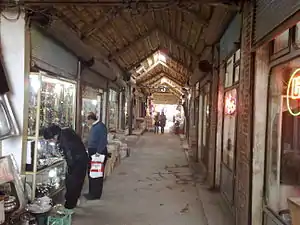Bazaar of Saqqez
The Bazaar of Saqqez is a historical complex and place of trade of various goods between merchants of the region and across Iran, which is located in the center of Saqqez and plays a major role in the trade of various goods between Iran, Iraq and Turkey.[1][2][3]
| Bazaar of Saqqez | |
|---|---|
بازارِ سقز | |
 | |
| General information | |
| Architectural style | Kurdish |
| Location | Saqqez, Iran |
| Coordinates | 36°14′47″N 46°15′59″E |
| Construction started | mid 1800s |
| Technical details | |
| Structural system | Bazaar (Welfare) |
| Size | 30,000 m2 (presumed) |
| Design and construction | |
| Architect(s) | Zand territories |
History
This Bazaar is one of the historical places of Rojhalat, which according to the remaining buildings of caravanserais and bazaars such as Tajvanchi Caravanserai and Jewish Bazaar, dates back to the time of Zandieh, which flourished and was restored during the Safavid and Qajar eras. The revival of historical bazaar centers such as Haj Saleh Hammam, Domenareh Mosque and caravanserais and the construction of a historical museum are being studied and carried out.[4][5][6]
The structure of the Bazzar
This bazaar consists of two main parts between the Castle bazaar and Sarpacheh bazaar, which are separated by the covered river Vali Khan (now Fakhr Razi Street). Saqqez Bazzar consists of several smaller Bazaars that are divided according to the goods offered and the sellers. These markets include the "Bazzar of Bala", which sells luxury goods, and the "Bazzar of Paein", which sells traditional goods such as textiles, wedding accessories and agricultural items. There are other markets, such as the Jewish market, which is now home to tailors and clothing manufacturers, and the Kazakhkhaneh market, which is now widely visited by travelers.[7][8][9]
Specification
Saqez Bazaar is known as the fabric hub of Iran due to the large number of shops and merchants of textiles and clothing, and this market is one of the main centers for the distribution of textiles and clothing in the region and Iran, with more than 500 main shops and markets of textiles and clothing. Sales of especially Kurdish women's clothing fabrics are active in the complex of shops and markets of the Silk bazaar, behind the Day Bazaar (Kazakhkhaneh), Ardalan Bazaar, Bala Bazaar and Azadi Underpass.[10][11][12][13]
Gallery
 Ardalan Bazzar
Ardalan Bazzar Jewish Bazzar in 2013
Jewish Bazzar in 2013
References
- بازار قدیمی سقز با اجناس و سوغاتیهای فراوان ، Young journalists club، 2015
- درخشش نگین ها و یاقوت ها در بازار سنتی سقز، DangiShar، 2017
- شهرستان سقز، Saqqez Islamic Azad University official website
- بازار تاجوانچي از آثار مهم تاريخی سقز بازسازی خواهد شد، IRNA، 2013
- طرح مطالعات احیای بافت تاریخی بازار سقز تکمیل شد، IRNA، 2020
- راهکارهایی برای احیا و توسعه بازار تاریخی و تجاری سقز Archived 2022-01-10 at the Wayback Machine، Kurdtoday، 2014
- بازار بزرگ سقز، IRIB official website، 2013
- ضرورت ساماندهی جمعه بازار سقز Archived 2022-01-10 at the Wayback Machine، Kurdtoday، 2017
- بازار سقز ، بازاری با اجناس و سوغاتی های فراوان، Jazebeha Website
- سقز؛ قطب پارچه کوردستان و ایران، Saqqezrudaw، 2019
- سقز قطب پارچه، پوشاک و لوازم خانگی کشور است ، Bornanews، 2016
- سقز، شهر پارچه های محلی/ استقبال چشمگير گردشگران از بازار، IRNA، 2017
- نمایشگاه مد و لباس سنتی ایران در سقز گشایش یافت ، IRNA، 2019
External links
- Kurdish clothing is one of the most diverse clothing in the world, Saqqezrudaw, 2021

